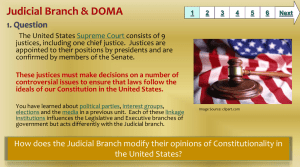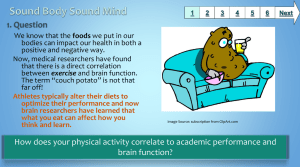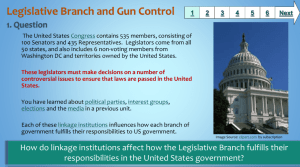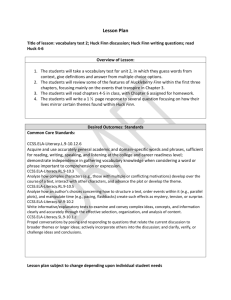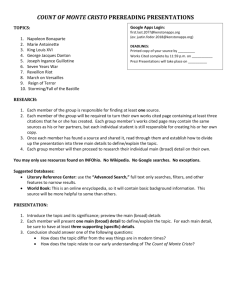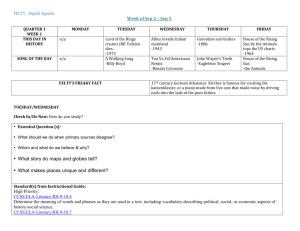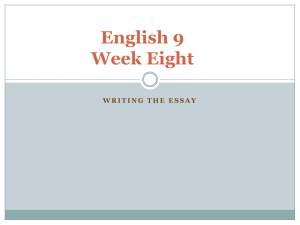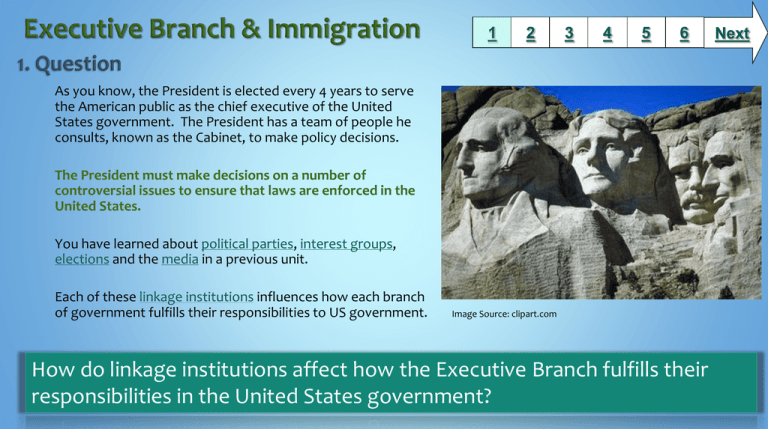
1
2
3
4
5
6
As you know, the President is elected every 4 years to serve
the American public as the chief executive of the United
States government. The President has a team of people he
consults, known as the Cabinet, to make policy decisions.
The President must make decisions on a number of
controversial issues to ensure that laws are enforced in the
United States.
You have learned about political parties, interest groups,
elections and the media in a previous unit.
Each of these linkage institutions influences how each branch
of government fulfills their responsibilities to US government.
Image Source: clipart.com
How do linkage institutions affect how the Executive Branch fulfills their
responsibilities in the United States government?
Next
1
2
3
4
5
Each of the linkage institutions can influence the Executive branch in
a number of ways. By researching the topic of Immigration, you can
investigate how each linkage institution has influenced the President.
Political Parties
Interest Groups
Immigration and the GOP
National Immigration Special Interest Groups
On the Issues – Democrats
On the Issues – Republicans
Immigration Shapes US Political Parties as much
as Demographics
Image Source: clipart.com
Elections
Media
2012 Election puts Spotlight on Immigration
Reform
How does the President use the media? Read
section titled “Molder of Public Opinion”
NBC-Learn: Republicans Face Challenging US
Electorate after 2012
‘Illegal’, ‘undocumented’, ‘unauthorized’: News
Media Shift language on Immigration
“Why This Time?” On Immigration, McCain Points
to ‘Elections’
6
Next
1
2
3
Using the resources on the
previous slide, create your own
notes pages or use the linked page
below to organize your ideas about
how your assigned linkage
institution(s) impact the Executive
Branch:
Notes
Image Source: infographicsarchive.com
4
5
6
Next
1
2
3
Use your notes to create a Prezi describing
how the linkage institution(s) you
researched has influenced the Executive
Branch in making decisions regarding
Immigration.
Be sure to include the following in your Prezi:
The name and a description of the linkage institution(s) you
researched
How does that linkage institution impact how the Executive
branch conducts their business of enforcing laws?
Refer to the following rubric to earn an A!
Image Source: clipart.com
4
5
6
Next
1
2
3
4
5
6
Next
The President often has projects that he is very passionate about,
even if others in government are not in favor of the policy.
How did the American people react differently to the Patient
Protection and Affordable Care Act (also known as “Obamacare”)?
Pro-Viewpoint
What is the Affordable Care Act?
Con-Viewpoint
Health Care Reform is a Disaster for All Americans
Image Source: clipart.com
Create a one-pager summarizing the information you’ve learned
about the Affordable Care Act expressing your own opinion.
1
2
BCPS Curriculum
Unit 5 – The Executive Indicator 1: Students will analyze the structures and powers of the Presidency in order to evaluate its effectiveness in developing and
instituting policy. (IV-AB)
Objective 6: Analyze the relationship between the President and linkage institutions.
Maryland State Curriculum
1. The student will demonstrate understanding of the structure and functions of government and politics in the United States . B. Individual and Group
Participation in the Political System. Indicator 1. The student will explain roles and analyze strategies individuals or groups may use to initiate change in
governmental policy and institutions (1.1.4). Objective b. Analyze the external factors that influence the law-making process including the roles of the media,
lobbyists, Political Action Committees (PACs), special-interest groups, citizens and public opinion (Unit 3) c. Analyze the role of the media, special-interest groups,
and public opinion in influencing the policy and decisions of the executive branch (Unit 4) d. Evaluate how the media, political parties, special-interest groups,
lobbyists, Political Action Committees (PACs) influence public opinion and government policies e. Evaluate the reliability and influence of the media on elections,
elected officials and public opinion f. Describe the roles of political parties in the United States and how they influence elections, elected officials and public
opinion g. Describe how citizens, candidates, campaigns and campaign financing influence the political process in the United States h. Analyze the roles of
participants in the election process including voting, contributing, and electioneering k. Analyze various methods that individuals or groups may use to influence
laws and governmental policies including petitioning, letter writing and acts of civil disobedience (Unit 7)
Common Core State Standards
CCSS.ELA-Literacy.RH.9-10.1 Cite specific textual evidence to support analysis of primary and secondary sources, attending to such features as the date and origin
of the information.
CCSS.ELA-Literacy.RH.9-10.3 Analyze in detail a series of events described in a text; determine whether earlier events caused later ones or simply preceded them.
CCSS.ELA-Literacy.RH.9-10.9 Compare and contrast treatments of the same topic in several primary and secondary sources.
CCSS.ELA-Literacy.WHST.9-10.2 Write informative/explanatory texts, including the narration of historical events, scientific procedures/ experiments, or technical
processes.
CCSS.ELA-Literacy.WHST.9-10.6 Use technology, including the Internet, to produce, publish, and update individual or shared writing products, taking advantage of
technology’s capacity to link to other information and to display information flexibly and dynamically.
CCSS.ELA-Literacy.WHST.9-10.7 Conduct short as well as more sustained research projects to answer a question (including a self-generated question) or solve a
problem; narrow or broaden the inquiry when appropriate; synthesize multiple sources on the subject, demonstrating understanding of the subject under
investigation.
Standards for the 21st Century Learner
1.1.6 Read, view, and listen for information presented in any format (e.g. textual, visual, media, digital) in order to make inferences and gather meaning.
2.1.3 Use strategies to draw conclusions from information and apply knowledge to curricular areas, real-world situations, and further investigations.
Maryland Technology Literacy Standards for Students
3.0: Use a variety of technologies for learning and collaboration.
3
4
5
6
Time Frame: 1 90 minute class period
Differentiation: Each graphic organizer can be
created by the students - does not need to use
the provided resources. Databases have text-tospeech features for some articles. Teacher can
choose to divide students in class by linkage
institution and have students create Infographic
on 1 institution.
Learning Styles: Field Dependent, Field Independent,
Visual, Auditory, Tactile, Reflective, Global
AVID Strategies:
inquiry based learning, Cornell notes, one pager,
rubric
Notes to the teacher:
Consult with your School Library Media Specialist
to implement this Slam Dunk Lesson.
Students can turn in activities by saving Cornell
notes/one pager and copying it to your school’s
student drive/printing and turning in
On gale resources, it may ask for a password –
username: bcps password: gale
Last updated: July 2015
Created by Jamie Higgins Shaull, Department Chair – Social Studies/Library Media Intern
BCPS Slam Dunk Research Model, Copyright 2012, Baltimore County Public Schools, MD, all rights reserved. The models may be used for educational, non-profit school use only.
All other uses, transmissions, and duplications are prohibited unless permission is granted expressly. This lesson is based on Jamie McKenzie’s Slam Dunk Lesson module.


